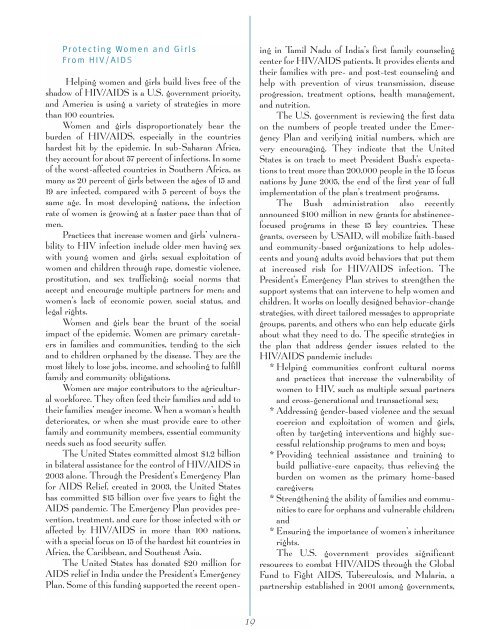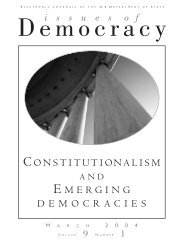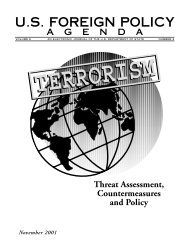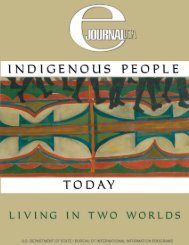Working for Women Worldwide - Embassy of the United States
Working for Women Worldwide - Embassy of the United States
Working for Women Worldwide - Embassy of the United States
Create successful ePaper yourself
Turn your PDF publications into a flip-book with our unique Google optimized e-Paper software.
Protecting <strong>Women</strong> and Girls<br />
From HIV/AIDS<br />
Helping women and girls build lives free <strong>of</strong> <strong>the</strong><br />
shadow <strong>of</strong> HIV/AIDS is a U.S. government priority,<br />
and America is using a variety <strong>of</strong> strategies in more<br />
than 100 countries.<br />
<strong>Women</strong> and girls disproportionately bear <strong>the</strong><br />
burden <strong>of</strong> HIV/AIDS, especially in <strong>the</strong> countries<br />
hardest hit by <strong>the</strong> epidemic. In sub-Saharan Africa,<br />
<strong>the</strong>y account <strong>for</strong> about 57 percent <strong>of</strong> infections. In some<br />
<strong>of</strong> <strong>the</strong> worst-affected countries in Sou<strong>the</strong>rn Africa, as<br />
many as 20 percent <strong>of</strong> girls between <strong>the</strong> ages <strong>of</strong> 15 and<br />
19 are infected, compared with 5 percent <strong>of</strong> boys <strong>the</strong><br />
same age. In most developing nations, <strong>the</strong> infection<br />
rate <strong>of</strong> women is growing at a faster pace than that <strong>of</strong><br />
men.<br />
Practices that increase women and girls’ vulnerability<br />
to HIV infection include older men having sex<br />
with young women and girls; sexual exploitation <strong>of</strong><br />
women and children through rape, domestic violence,<br />
prostitution, and sex trafficking; social norms that<br />
accept and encourage multiple partners <strong>for</strong> men; and<br />
women’s lack <strong>of</strong> economic power, social status, and<br />
legal rights.<br />
<strong>Women</strong> and girls bear <strong>the</strong> brunt <strong>of</strong> <strong>the</strong> social<br />
impact <strong>of</strong> <strong>the</strong> epidemic. <strong>Women</strong> are primary caretakers<br />
in families and communities, tending to <strong>the</strong> sick<br />
and to children orphaned by <strong>the</strong> disease. They are <strong>the</strong><br />
most likely to lose jobs, income, and schooling to fulfill<br />
family and community obligations.<br />
<strong>Women</strong> are major contributors to <strong>the</strong> agricultural<br />
work<strong>for</strong>ce. They <strong>of</strong>ten feed <strong>the</strong>ir families and add to<br />
<strong>the</strong>ir families’ meager income. When a woman’s health<br />
deteriorates, or when she must provide care to o<strong>the</strong>r<br />
family and community members, essential community<br />
needs such as food security suffer.<br />
The <strong>United</strong> <strong>States</strong> committed almost $1.2 billion<br />
in bilateral assistance <strong>for</strong> <strong>the</strong> control <strong>of</strong> HIV/AIDS in<br />
2003 alone. Through <strong>the</strong> President’s Emergency Plan<br />
<strong>for</strong> AIDS Relief, created in 2003, <strong>the</strong> <strong>United</strong> <strong>States</strong><br />
has committed $15 billion over five years to fight <strong>the</strong><br />
AIDS pandemic. The Emergency Plan provides prevention,<br />
treatment, and care <strong>for</strong> those infected with or<br />
affected by HIV/AIDS in more than 100 nations,<br />
with a special focus on 15 <strong>of</strong> <strong>the</strong> hardest hit countries in<br />
Africa, <strong>the</strong> Caribbean, and Sou<strong>the</strong>ast Asia.<br />
The <strong>United</strong> <strong>States</strong> has donated $20 million <strong>for</strong><br />
AIDS relief in India under <strong>the</strong> President’s Emergency<br />
Plan. Some <strong>of</strong> this funding supported <strong>the</strong> recent opening<br />
in Tamil Nadu <strong>of</strong> India’s first family counseling<br />
center <strong>for</strong> HIV/AIDS patients. It provides clients and<br />
<strong>the</strong>ir families with pre- and post-test counseling and<br />
help with prevention <strong>of</strong> virus transmission, disease<br />
progression, treatment options, health management,<br />
and nutrition.<br />
The U.S. government is reviewing <strong>the</strong> first data<br />
on <strong>the</strong> numbers <strong>of</strong> people treated under <strong>the</strong> Emergency<br />
Plan and verifying initial numbers, which are<br />
very encouraging. They indicate that <strong>the</strong> <strong>United</strong><br />
<strong>States</strong> is on track to meet President Bush’s expectations<br />
to treat more than 200,000 people in <strong>the</strong> 15 focus<br />
nations by June 2005, <strong>the</strong> end <strong>of</strong> <strong>the</strong> first year <strong>of</strong> full<br />
implementation <strong>of</strong> <strong>the</strong> plan’s treatment programs.<br />
The Bush administration also recently<br />
announced $100 million in new grants <strong>for</strong> abstinencefocused<br />
programs in <strong>the</strong>se 15 key countries. These<br />
grants, overseen by USAID, will mobilize faith-based<br />
and community-based organizations to help adolescents<br />
and young adults avoid behaviors that put <strong>the</strong>m<br />
at increased risk <strong>for</strong> HIV/AIDS infection. The<br />
President’s Emergency Plan strives to streng<strong>the</strong>n <strong>the</strong><br />
support systems that can intervene to help women and<br />
children. It works on locally designed behavior-change<br />
strategies, with direct tailored messages to appropriate<br />
groups, parents, and o<strong>the</strong>rs who can help educate girls<br />
about what <strong>the</strong>y need to do. The specific strategies in<br />
<strong>the</strong> plan that address gender issues related to <strong>the</strong><br />
HIV/AIDS pandemic include:<br />
* Helping communities confront cultural norms<br />
and practices that increase <strong>the</strong> vulnerability <strong>of</strong><br />
women to HIV, such as multiple sexual partners<br />
and cross-generational and transactional sex;<br />
* Addressing gender-based violence and <strong>the</strong> sexual<br />
coercion and exploitation <strong>of</strong> women and girls,<br />
<strong>of</strong>ten by targeting interventions and highly successful<br />
relationship programs to men and boys;<br />
* Providing technical assistance and training to<br />
build palliative-care capacity, thus relieving <strong>the</strong><br />
burden on women as <strong>the</strong> primary home-based<br />
caregivers;<br />
* Streng<strong>the</strong>ning <strong>the</strong> ability <strong>of</strong> families and communities<br />
to care <strong>for</strong> orphans and vulnerable children;<br />
and<br />
* Ensuring <strong>the</strong> importance <strong>of</strong> women’s inheritance<br />
rights.<br />
The U.S. government provides significant<br />
resources to combat HIV/AIDS through <strong>the</strong> Global<br />
Fund to Fight AIDS, Tuberculosis, and Malaria, a<br />
partnership established in 2001 among governments,<br />
19












